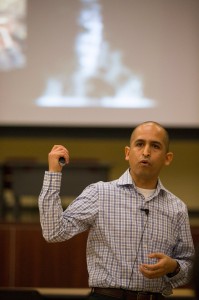Expert discusses Frida Kahlo’s influence in science
Members of the USC medical community came together on Monday at Mayer Hall on the Health Sciences Campus to listen to Dr. Fernando Antelo discuss the medical aspects of the artwork of Frida Kahlo as part of Hispanic Heritage Month.

Scientific art· Dr. Fernando Antelo lectures students and faculty on the incorporation of science and medicine in artist Frida Kahlo’s work. – Ralf Cheung | Daily Trojan
The event, hosted by the Latino Medical Student Association, incorporated music and an authentic Mexican lunch into the discussion of Kahlo’s paintings, which allowed attendees to view medicine through a more cultural lens.
“Monica [Melgar], our co-chair, really wanted to have an event that wasn’t just about medicine,” said Susana Sandoval, a second year medical student and the secretary of LMSA. “She didn’t want a medical talk. She wanted to incorporate some art, some Latino art.”
Antelo, a forensic pathology fellow at the Los Angeles County Department of Coroner, has conducted similar cultural and scientific presentations in several parts of the state, including at UCLA and UC San Diego.
Antelo attended Loyola High School in Los Angeles, received his bachelor’s degree at UC Berkeley, earned his medical degree at the Olive View University of California Medical Education Program and then completed his residency training in anatomic and clinical pathology at Harbor UCLA Medical Center.
Throughout his presentation, Antelo developed a sense of understanding science through artwork by going through the different body parts that Kahlo incorporates into her paintings. Some of the more notable scientific elements in her artwork include the depiction of fetuses and pain from medical abnormalities.
“I learned that Frida Kahlo actually has a significant background in science and biology and that it can be incorporated in artwork in a lot of different ways,” said Mercy Bechtold, a first year medical student.
Monica Melgar, one of the co-presidents of LMSA, saw this event as an opportunity to celebrate both Latino culture and Latinos in the medical field.
“Our E-board here at the LMSA chapter really thought it was important to get the campus community involved with just promoting our culture. Being in L.A. is such a big place to embrace that,” Melgar said. “We all felt it was important to kind of celebrate and embrace this part of our growing diversity in the medical field.”
Many non-LMSA students also attended the event.
“[We went] because when we actually were walking in, we saw the beginning of the presentation, and it looked interesting,” said Kayvon Sotoudeh, a first year medical student.
Some students said they were interested in learning about the relationship between art and science.
“I heard from someone in the hallway that he looks at her paintings and can really find interesting medical correlations to her as an artist, so I thought that was pretty cool,” said Kelli Thompson, a first year medical student.
The Kahlo talk was just one of many events LMSA hopes to put on to attract more Latino students to medical fields.
“I want to have more Latinos go into medicine and know that when they do get to medical school, they’re going to have a community to go to,” Sandoval said.
Even for the non-Latino medical community, the presentation encouraged students who did not think of themselves as artistic to appreciate an unfamiliar field.
“I think they really bring a good element of humanities and appreciation for the humanities to a more scientifically-oriented audience, and it opens up our eyes a little bit more,” Thompson said.
Follow us on Twitter @dailytrojan

I never knew art could be so tired to science. This event seems really interesting, I wish I could have gone!